








The magazine of the art-form of the photo-essay

July 2016 back issue


by Aaron Vincent Elkaim

“A free, really high quality photo-essay magazine. Fabulous!”
Stephen Fry. British actor, writer and film & documentary maker


In the 1960s the Cree and Dene First Nation Reserve of Fort McKay situated on the Athabasca River in Northern
Alberta’s Boreal forest had no running water, the people lived in shacks and there were no roads connecting it to the
rest of Canada. They sustained themselves off a traditional economy of hunting and trapping as their ancestors
practiced in the region for thousands of years. But as community elder Zackary Powder says, “Its not like it used to be,
everything has changed.”
Since 1778 the Athabasca was part of the main fur trade route from the Mackenzie River to the Great Lakes employing
local Natives as fur Trappers. Fur from the region helped fuel the Canadian colonialist economy. Today, the Canadian
economy remains supported by the regions resources, but the fur fueled Hudson’s Bay Company is only a memory
here, replaced by the likes of Syncrude, Total, Shell, Imperial Oil and Suncor, formerly the Great Canadian Oil Sands,
which on June 6, 1970, spilled 19,000 barrels of oil from a ruptured pipeline into the river. 30km downstream the Cree,
Dene and Metis people of Fort McKay fished to feed their families.
Along the riverbanks and beneath the trees lies the third largest oil deposit in the world. It is known as the Oil Sands,
an unconventional oil that is deposited in 140,000 sq kilometers of sand and earth beneath the region’s Boreal forest.
The extraction of this oil has devastated the ecology of this once pristine region, clearing the forests, poisoning the
rivers and creating massive toxic tailings ponds held back from the river by the largest earthen dams in the world.
Fort McKay First Nation is surrounded by Oil Sands development, what has become the largest industrial operation in
the world. With the collapse of the fur trade and a growing inability to live off the polluted land, Fort McKay was faced
with a choice. Work for the oil companies, or fall into the poverty that plagues reserves across Canada. In 1986 they
created the Fort McKay Group of Companies, which today grosses over $700 million annually providing services to
industry. Without access to healthy land, the community struggles to maintain their cultural activities. The animals they
hunt are rarely seen, they can no longer eat the fish from the river or drink their water and many believe the health of
the community is being impacted by high rates of cancer, asthma and miscarriage.
Sleeping with the Devil examines the transitory state of the community of Fort McKay. Prospering within an economy
that is destroying their land they must negotiate an inner conflict and an uncertain future as their values, health and
culture are traded for a standard of living most Canadians take for granted.
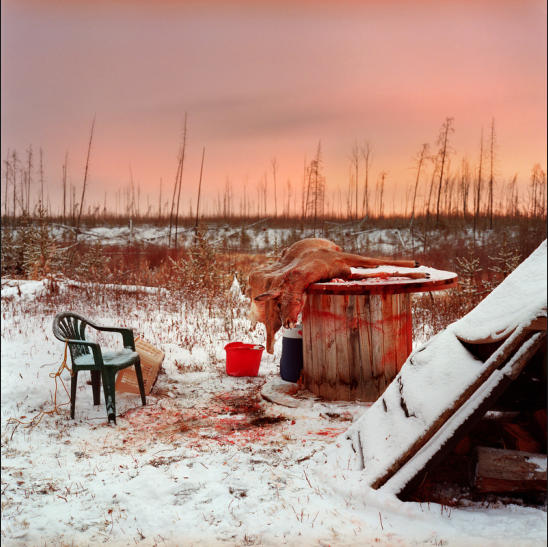
December 2011- A deer sits half skinned on the L'Hommecourt trapline located next to
Imperial Oil's Kearl Oil Sands project. Traplines are partitions of land allocated to individuals
and passed down through families for hunting and trapping. Most have cabins and often serve
as family getaways into the bush. Many of the regions traplines have been excavated or
disturbed by the Oil Sands industry with the title holders often receiving compensations for the
use of the land.
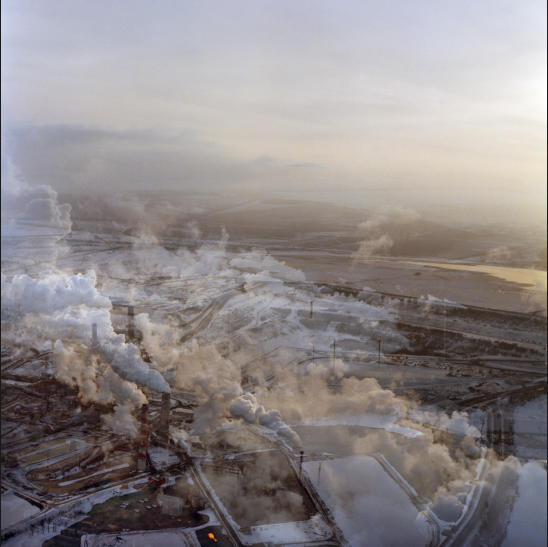
February 2012 - A multiple exposure the of Suncor Oilsands facility, formerly the Great
Canadian OilSands CO. Suncor was the first oil sands development and is the second largest
operation after Syncrude. It employs strip mining, where the forest or "overburden" is cleared,
then the earth is shovelled and processed with large amounts of water heated with natural gas
to separate the oil-like bitumen from the sand.
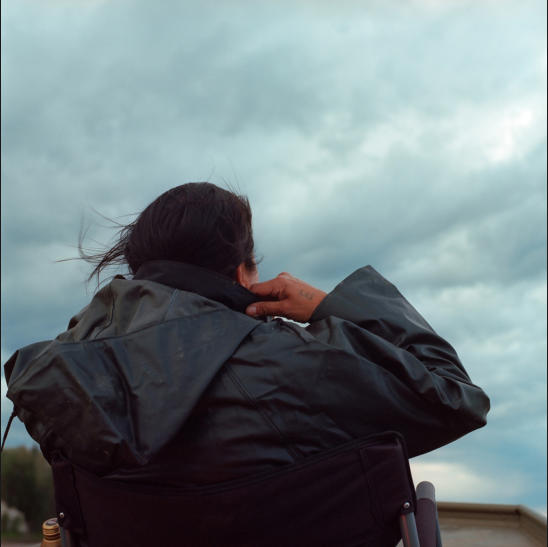
July 2012 - Yvonne L'Hommecourt boats up the Athabasca river while returning to Fort McKay
after spending a weekend in ‘the Bush’ at Poplar Point Reserve, between Fort McKay and
Fort Chipewyan where she spent summers as a child and where her father is buried. Yvonne
works as a truck driver for Suncor, hauling tar sands, she spends most of her free time out on
the land.
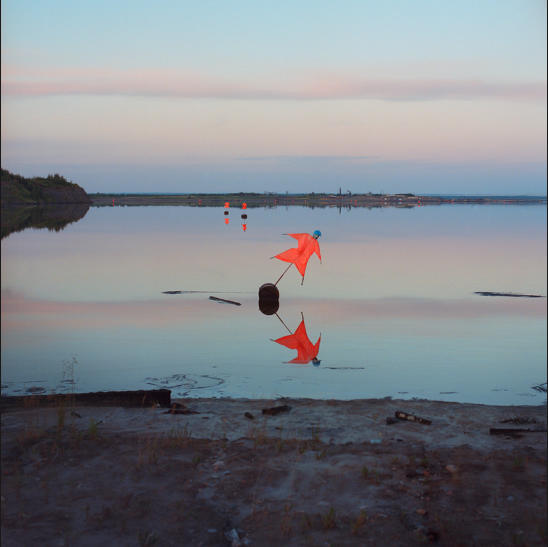
July 2013 - Scarecrows called ‘Bitumen’ and propane canons are used to scare away
migratory birds so they don't land in a tailings pond owned by Suncor Energy.
The Canadian oil sands operations use 349 million cubic metres of water per year, twice the
amount of water used by the city of Calgary. Most of this ends up in massive tailings ponds
that constantly leach toxins into the nearby Athabasca river.
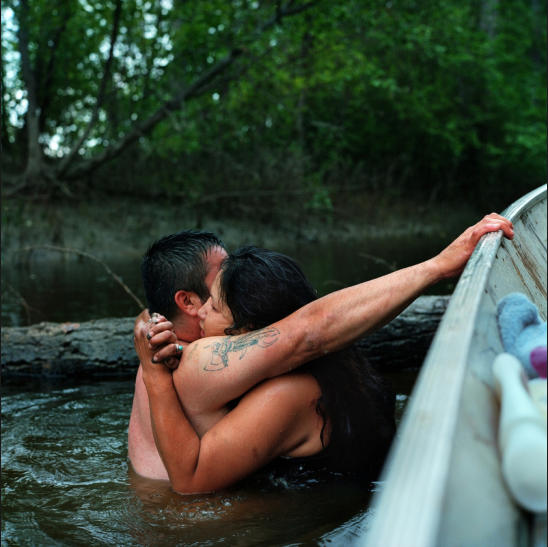
July 2013 - Mark John L'Hommecourt embraces Amanda Grandjambe while bathing in a creek
off of the Athabasca River near the historic Poplar Point Reserve, where Mark spends his time
in the ‘Bush’ away from Fort McKay. Grandjambe who speaks her native Cree language has
recently been diagnosed with Cancer which seems to be occurring at abnormally high levels
within the community.
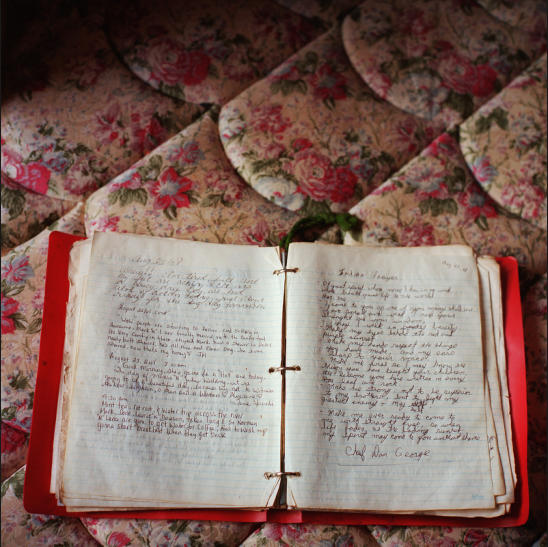
March 2013 - A log book with stories from visitors at Poplar Point Reserve. Poplar Point is a
historic meeting place for First Nations along the Athabasca River between Fort McKay and
the more northern reserve of Fort Chipewyan. Today it has a few cabins and serves as a place
to practice traditional hunting and foraging away from the industrial landscape now
surrounding Fort McKay.
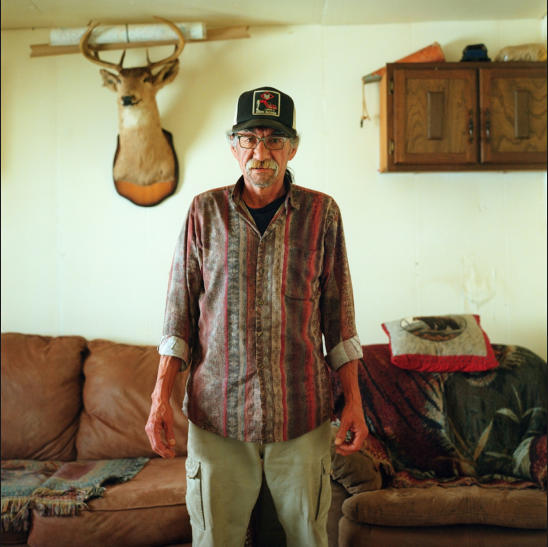
July 2013 - Roy Ladouceur, born March 30, 1954 in Fort Chipewyan spends much of his year
trapping at Poplar Point Reserve on the Athabasca River between Fort McKay and Fort
Chypewyan . Through his years of living on the land he has been a witness to the impacts the
Oil Sands have had on his traditional land and has spoken out against new developments.
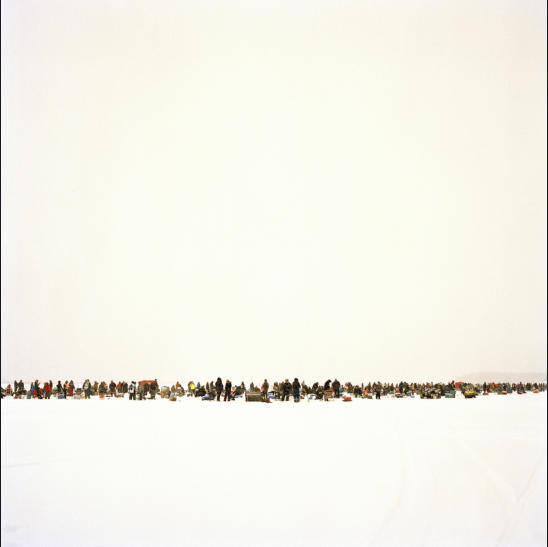
March 2013 - People from all around the region come to Fort Chipewyan each year for their
fishing derby on Lake Athabasca. The prizes this year were $5000, a boat and motor and a
Quad ATV donated by the oil company Suncor. Many local residents complain that they can no
longer eat the fish from the lake due to contamination from the oil sands industry upriver,
many fish are found with abnormal tumours and lesions.

February 2012 - Crystal and Oren Boucher celebrate their marriage in the Fort McKay First
Nation Band Hall. Oren who was a long time employee of Suncor had terminal colon cancer
at the time of his wedding, he passed away one year later on the night of his grandfather and
oldest community elder, James Grandjambe's, birthday party. Cancer, miscarriage and
respiratory illnesses are frequently reported in Fort McKay.
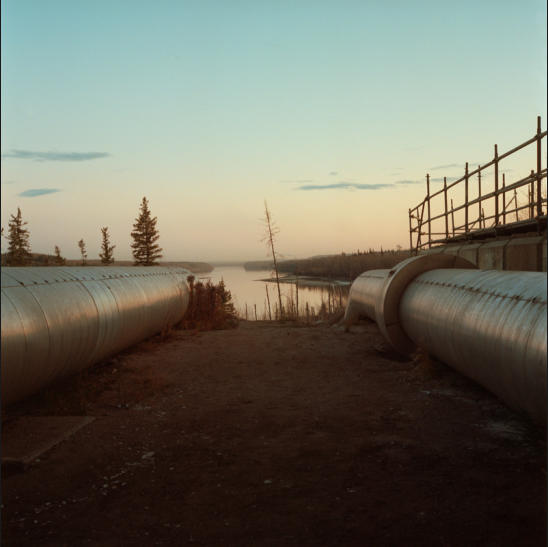
2011 - The Athabasca River feeds the Athabasca Delta, the third largest fresh water delta in
the world it also feeds the water needs of most of the large Oil Sands operations. Locals
complain that pollution has effected the fish, saying they taste oily and have tumours, most
refuse to eat them. Locals claim that the water level has dropped significantly and that beavers
and other wildlife no longer make the river their home.
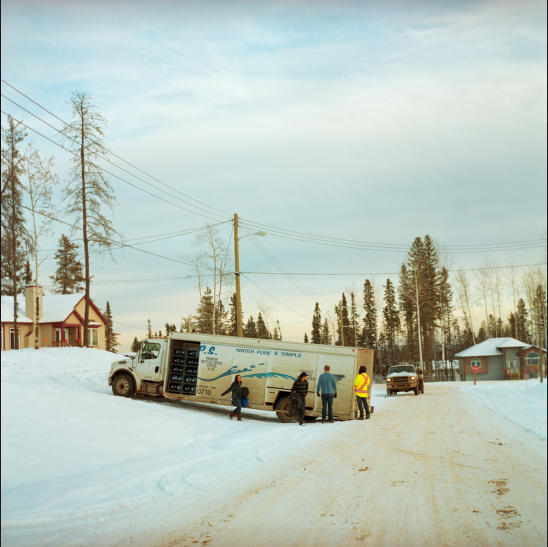
Since november 2011, water is being delivered to each and ever home in Fort McKay after the
community realized they had been drinking water with high levels of certain carcinogenic
chemicals since 1994. Health Canada who had been doing the testing failed to notified the
community as they did not want to cause ‘undue alarm.’
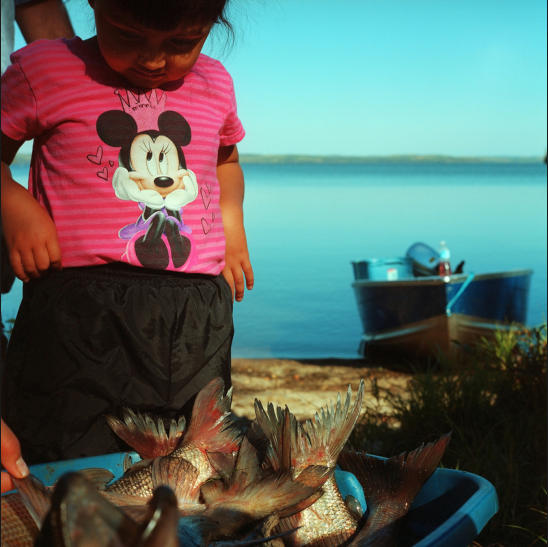
September 2013 - Joely Grandjambe, 3, looks at a catch of White Fish and Pickerel that were
netted at Moose Lake Reserve. Moose Lake is the only hunting ground left for the Fort McKay
First Nation that is still pristine, but a proposed development called the Dover Project that will
border Moose Lake is threatening the health of the land and water.
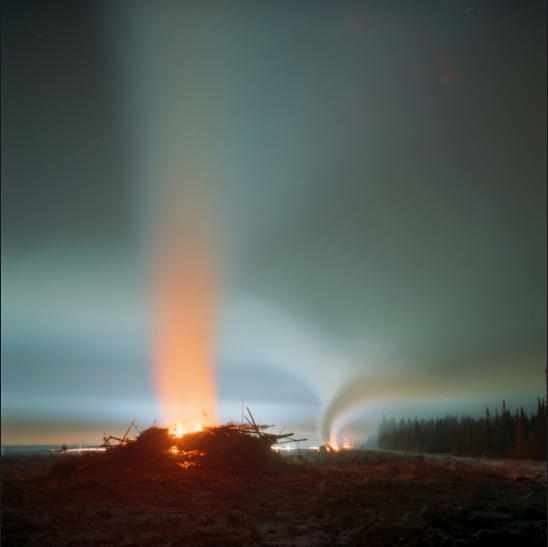
February 2012 - Overburden, an industry term for the natural material that lies above an area
of economic interest, is burned at night on the TOTAL lease near Fort McKay First Nation,
Alberta. Here strip mining will take place, where they first clear the forest, then proceed to dig
up the earth containing the bitumen laced sand. Four months earlier the area was boreal forest
with many trails used by the First Nations of Fort McKay.
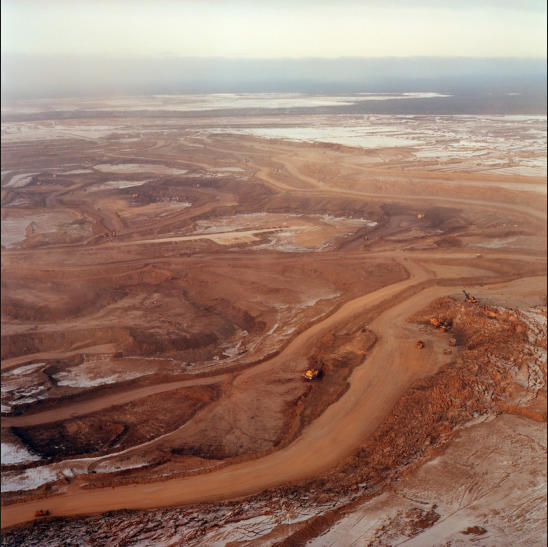
February 2012 - Suncor, formerly the Great Canadian OilSands CO., was the first oil sands
development and is the second largest operation. It employs strip mining, where the forest or
‘overburden’ is cleared, then the earth is shovelled and processed to separate the oily bitumen
from the sand. The process requires large amounts of water and creates huge tailings ponds
that have proven problematic for reclamation.
This land was once all Boreal Forest, and under the current regulations every square mile of
mine must be returned to near original condition and productive state after mining is complete,
a feat that has yet to be proven possible.
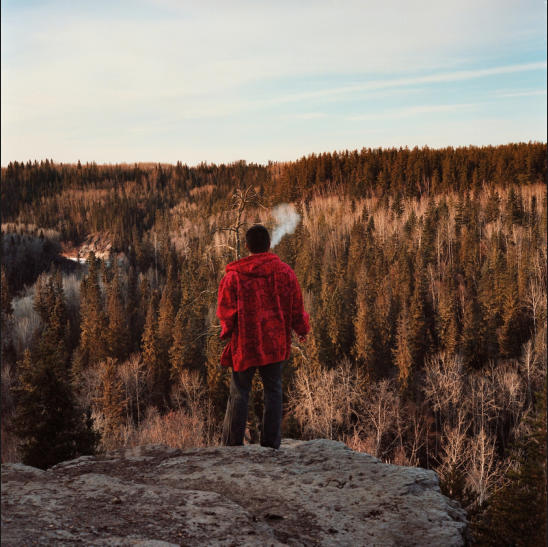
Nov. 2011. Mark L'Hommecourt smokes a cigarette on a the Target Road lookout on the Fort
McKay reserve. Mark is adamantly against the destruction of his land by industry, but has
been forced to work for them due to the lack of other opportunities in the region. Something he
claims creates a deep conflict within him.





